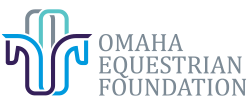About the Author: Jane Fucinaro is a United States Dressage Federation Certified Instructor through Second Level, Bronze Medalist and owner of the barn, Coda Cavallo in Omaha. Her passion in training stems in clear communication to the horse through use of effective equitation and correct aids. In teaching, Jane emphasizes understanding of the WHY, WHAT and HOW to the student, and encourages ownership of lessons and information to develop confident riders.
Scenario One: You are in the midst of a riding lesson under your trainer’s watchful eyes, concentrating SO intently on positioning yourself and your horse just right to execute the instructions you’re paying valuable money for. Before you realize it, tension creeps in, your hips stiffen, horse hollows, starts getting stuck underneath you, and things start going wrong.
Scenario Two: Your riding buddies invite you and your horse on a trail ride. It’s a beautiful day and suddenly you spot a plastic bag flapping from a tree ahead. You’re far enough away, maybe you can keep your horse busy enough she won’t see it. Nonetheless, her gaze falls to the bag and she freezes.
You and I could go on and on about the frightful or intense situations we’ve encountered while interacting with our horses. We’ve all been there. I want to share some advice that has been life-changing for me in my awareness of horses and self— that is breath.
Gaining awareness and control over your breathing is an impactful tool for improving communicative flow with your horse. Sounds simple, right? In my experience, it takes mental stamina, self-awareness and practice.
Let’s do an exercise together. As you sit here, take a moment to become aware of how your chest feels. Is the rise and fall of your chest shallow or deep? Does it feel easy to take in a deep breath, or is there tension as you do? Are you exhaling as much as you inhale? Are you met with any tension or pain in your ribs, back or neck? If so, take a slow breath from your nose. Find that spot where it’s a little tight, and focus on sending breath there. Repeat for a full minute. How do you feel? I’ll bet your heart rate is a little lower, and you’re feeling looser. How can this help in our riding? I’m going to give you a few examples of where breath work has helped me.
Many of us begin with a little groundwork with our horses. Part of making a safe space for our horse is allowing relaxation in, and letting worries, fear or anger from the day OUT. Before I ask the horse to move, I have a moment of stillness where I take a few deep breaths. Horses are the greatest imitators, and it’s so fun to watch them mimic myself and students when we do this. I stand at a comfortable distance away from the horse and draw a deep breath in, setting my intention for our time together. In my exhale, I often make a verbal sound such as a sigh, or a horse blowing out noise from my lips. Chances are, if you spend a few minutes just holding space for your horse, she will begin to match you.
As I mount on my horse, I begin on a loose rein with no stirrups, if the circumstances are safe to do so. I give myself time during the walk warm up to find a rhythm in my horse’s four-beat walk, finding swing in my hips and matching that to their back. Like most equestrians you and I know, we have some aches and pains when we start. As I focus on the 1-2-3-4 of the horse’s walk, I begin to count “INHALE -2-3-4, HOLD 2-3-4, exhale 2-3-4, HOLD 2-3-4″ and repeat, progressively deepening my breath. As my breath gets deeper, I draw it into my hips, letting my body swing and relax with the horse’s back. This exercise can be practiced in all gaits of the horse in time with their stride rhythm.
Why does this breathing practice help the horse? Not only does it help to clear our minds of our daily clutter and bring us into focus, it has many physical benefits that aid in our riding position. The psoas is a deep muscle in our body that connects the lumbar area of our back to our femur, possessing deep ties into our diaphragm. It’s often called the “emotion muscle” of our body, due to the fact that it is a major contributor to our instinctual “fight or flight” reaction. When riding, our goal is to follow the horse’s motion, sitting with their back, rather than against or into it, this can only be achieved with a psoas that isn’t restricting or tense. Practicing breath work while riding is a fantastic way to break the cycle of fear that can cause a flight (tensing) reaction in the psoas. Because the psoas ties in so deeply around our spine and pelvic floor, activating the diaphragm through a series of thoughtful inhales and exhales can get your psoas to release.
Picture the scenarios I mentioned in the beginning. When we try too hard in a lesson or when we get spooked on a trail, we can harness the power of our breath to bring our mind and body into a place of relaxation and receptiveness of the horse’s motion. Freezing on the horse’s back only creates additional tension. Learning to follow and relax, even when your instincts tell you otherwise, is a great skill that we can all master.
I hope these practices bring some peace and relaxation into your next interaction with your horse. Happy horsing!

